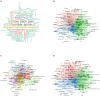Research trend of MRI application for lumbar disc degeneration with low back pain: a bibliometric analysis
- PMID: 38694782
- PMCID: PMC11061404
- DOI: 10.3389/fneur.2024.1360091
Research trend of MRI application for lumbar disc degeneration with low back pain: a bibliometric analysis
Abstract
Background: Low Back Pain (LBP) is a pervasive and complex musculoskeletal condition affecting over 80% of the global population. Lumbar Disc Degeneration (LDD) significantly contributes to LBP, and MRI is crucial for its diagnosis and understanding. This study aimes to provide a comprehensive bibliometric analysis of MRI research on LDD with LBP, shedding light on research patterns, collaborations, and potential knowledge gaps.
Methods: A comprehensive online search was conducted in the Scopus database to retrieve published literature on LDD with LBP. Bibliometric analysis was conducted to assess publication patterns, co-authorship networks, keyword co-occurrence, and co-citation analysis within the MRI applications for LDD research domain. Bibliometric analysis tools such as VOSviewer and the R package "bibliometrix" were utilized for quantitative assessments.
Results: A total of 1,619 publications related to MRI and LDD were analyzed. The analysis indicated a consistent annual growth rate of 4.62% in publications related to MRI and lumbar disc degeneration, reflecting a steady increase in research output over the past two decades. The USA, China, and Japan emerged as leading contributors. "SPINE", "European Spine Journal", and "Spine Journal" were the most productive journals in this domain. Key research themes identified included lumbar spine, low back pain, and magnetic resonance imaging. Network visualization shows that low back pain and magnetic resonance imaging were the most widely used keywords.
Conclusion: The comprehensive bibliometric analysis of MRI applications for Lumbar Disc Degeneration offers insights into prevailing research patterns, highlights key contributors and journals, and identifies significant research themes. This study provides a foundation for future research efforts and clinical practices in the field, ultimately contributing to the advancement of patient care for individuals suffering from LDD and associated Low Back Pain.
Keywords: MRI applications; bibliometric analysis; low back pain; lumbar disc degeneration; magnetic resonance imaging.
Copyright © 2024 Saeed, Shao, Hezam, Liu, Zhang and Tang.
Conflict of interest statement
The authors declare that the research was conducted in the absence of any commercial or financial relationships that could be construed as a potential conflict of interest.
Figures














Similar articles
-
The role of co-occurring insomnia and mental distress in the association between lumbar disc degeneration and low back pain related disability.BMC Musculoskelet Disord. 2023 Apr 14;24(1):293. doi: 10.1186/s12891-023-06365-2. BMC Musculoskelet Disord. 2023. PMID: 37060071 Free PMC article.
-
Association of lumbar disc degeneration with low back pain in middle age in the Northern Finland Birth Cohort 1966.BMC Musculoskelet Disord. 2022 Apr 15;23(1):359. doi: 10.1186/s12891-022-05302-z. BMC Musculoskelet Disord. 2022. PMID: 35428226 Free PMC article.
-
Lumbar disc degeneration and genetic factors are the main risk factors for low back pain in women: the UK Twin Spine Study.Ann Rheum Dis. 2011 Oct;70(10):1740-5. doi: 10.1136/ard.2010.137836. Epub 2011 Jun 6. Ann Rheum Dis. 2011. PMID: 21646416 Free PMC article.
-
Research Trends of the Research and Development of Acupuncture and Moxibustion Therapy on Lumbar Disc Herniation: A Bibliometric Analysis.J Pain Res. 2023 May 31;16:1835-1853. doi: 10.2147/JPR.S400362. eCollection 2023. J Pain Res. 2023. PMID: 37284329 Free PMC article. Review.
-
Trends of Low Back Pain Research in Older and Working-Age Adults from 1993 to 2023: A Bibliometric Analysis.J Pain Res. 2023 Oct 2;16:3325-3341. doi: 10.2147/JPR.S425672. eCollection 2023. J Pain Res. 2023. PMID: 37808461 Free PMC article. Review.
References
-
- GBD 2017 Disease and Injury Incidence and Prevalence Collaborators . Global, regional, and national incidence, prevalence, and years lived with disability for 354 diseases and injuries for 195 countries and territories, 1990-2017: a systematic analysis for the Global Burden of Disease Study 2017. Lancet. (2018) 392:1789–858. 10.1016/S0140-6736(18)32279-7 - DOI - PMC - PubMed
-
- GBD 2021 Low Back Pain Collaborators. Global, Regional, and national burden of low back pain, 1990-2020, its attributable risk factors, and projections to 2050: a systematic analysis of the Global Burden of Disease Study 2021. Lancet Rheumatol. (2023) 5:e316–e29. 10.1016/S2665-9913(23)00098-X - DOI - PMC - PubMed
Publication types
LinkOut - more resources
Full Text Sources
Miscellaneous

